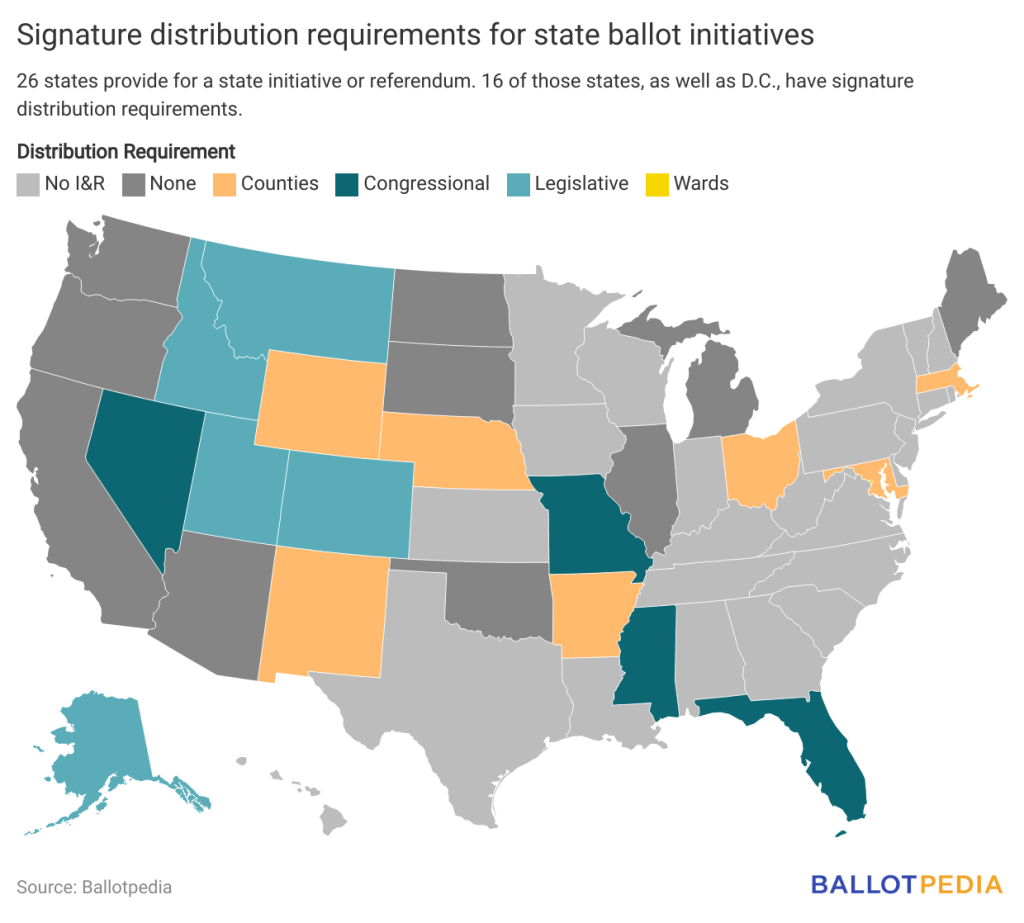Ohio Issue 1 would make several changes to the state’s citizen-initiated constitutional amendment process. These changes include requiring a 60% vote for amendments, increasing the signature distribution requirement, and eliminating the signature cure period.
Yesterday, we reviewed one of these changes—the 60% vote threshold—within the context of other states and historical ballot measures. Today’s article compares Ohio’s current and proposed signature distribution requirements to those of other states and the legal landscape surrounding distribution requirements.
A signature distribution requirement, also known as a geographic signature requirement, is a law that provides that ballot initiative petitions must be signed by voters from multiple political subdivisions, such as counties or legislative districts, in order for the initiative to qualify for the ballot.
Currently, campaigns for citizen-initiated constitutional amendments in Ohio must collect signatures equal to 5% of the votes cast for governor in each of 44 of the state’s 88 counties. Overall, campaigns need to collect signatures equal to 10% of the votes cast for governor statewide, which is 413,487 signatures in 2023.
Under Issue 1, the distribution requirement would increase to 5% of the votes cast at the last gubernatorial election in each of the state’s 88 counties, rather than 44 of them.
An expanded distribution requirement is a type of legislative change that Ballotpedia classifies as making the ballot initiative process more difficult, which we define as more resource-intensive for initiative proponents.
Of the 26 states that provide for statewide citizen-initiated ballot measures, 16 states require signature distribution requirements, including Ohio. Seven states require campaigns to collect signatures from a certain percentage of voters in a number of counties, while five states require signatures from a certain percentage of voters in state legislative districts. Four states require signatures from a certain percentage of voters in congressional districts. Washington, D.C., as well as some cities throughout the U.S., also have distribution requirements for local citizen-initiated ballot measures, which are often based on ward districts.

If Issue 1 is approved, Ohio would become the only state to require campaigns to collect signatures from 100% of the state’s counties. Ohio has 88 counties, which range in population from 12,565 people in Vinton County to 1.32 million people in Franklin County. Colorado and Nevada also have signature distribution requirements that require campaigns to gather signatures from each subdivision of the state. In Colorado, campaigns must collect signatures from each of the state’s 35 Senate districts, and in Nevada, campaigns must collect signatures from each of the state’s four congressional districts.
The other states that have county-based signature distribution requirements are:
- Arkansas, which requires signatures equal to 5% of votes cast for governor in 50 of 75 counties;
- Maryland, which provides that no more than half of the required signatures for referendums can come from any one county, or Baltimore, which is an independent city;
- Massachusetts, which provides that no more than 25% of the required signatures can come from any one county;
- Nebraska, which requires signatures from 5% of registered voters in 40% (38) of the state’s 93 counties;
- New Mexico, where referendum campaigns need to collect signatures equal to 10% of the votes cast at the last general election in 75% (25) of the state’s 33 counties; and
- Wyoming, which requires signatures equal to 15% of votes cast in the last general election in each of 2/3 (16) of the state’s 23 counties.
County-based signature distribution requirements for ballot initiatives have been struck down by federal courts in some cases. For example, the 9th Circuit Court of Appeals ruled that such requirements violate the U.S. Constitution’s Equal Protection Clause because counties “vary drastically in the size of their population,” which can “dilute the vote of residents of densely populated counties.” However, the 8th Circuit Court of Appeals upheld a county-based distribution requirement in Nebraska, ruling that the Equal Protection Clause does not apply to state ballot initiatives because they are a state-based process not guaranteed by the U.S. Constitution. Ohio is located within the 6th Circuit’s jurisdiction.
Ohio is one of three states to take action on signature distribution requirements in 2023. In Arizona, the state Legislature referred a constitutional amendment related to distribution requirements to the ballot for Nov. 2024. Arizona doesn’t have a distribution requirement. The amendment would require signatures to be collected from each of the state’s 30 legislative districts. This would be the broadest requirement of any state using a state legislative district-based distribution requirement.
Arkansas also increased its distribution requirement earlier this year, from 15 of 75 counties to 50 of 75 counties. This came after voters rejected a constitutional amendment in 2020 that would have increased the requirement from 15 to 45 counties.
Regarding Ohio Issue 1, both supporters and opponents agree that the expanded distribution requirement would have a significant effect on citizen-initiated constitutional amendment campaigns.
- State Sen. Rob McColley (R-1) and Rep. Brian Stewart (R-12), who wrote the official arguments in support of Issue 1, said, “By requiring signatures from voters in every county, special interests will no longer be able to cherry pick where they gather signatures. Instead, starting January 1, 2024, a diverse and representative population of Ohioans will determine whether proposed amendments appear on the ballot.”
- Sarah Walker, the legal and policy director for the Ballot Initiative Strategy Center, stated, “While nothing is impossible, the new geographic signature requirements create monumental hurdles including increased costs for citizen led campaigns and creating a system that advantages only the most well-resourced special interests. If the stated purpose of Issue 1 was to limit the influence of outside special interests on the Ohio Constitution, these onerous geographic signature requirements do precisely the opposite.”
The new signature distribution requirement would go into effect on Jan. 1, 2024, if Issue 1 is approved by voters on Aug. 8.
Are you interested in learning more about Ohio Issue 1?
Tomorrow, we will publish data on how many Ohio constitutional amendments have been approved, defeated, and which ones would have failed Ohio Issue 1’s supermajority requirement if it had been in effect. On Monday, we will discuss how Issue 1 fits into the ballot measure legislation landscape in 2023.
Click here to read our page on Ohio Issue 1, and see the links below for our previous articles on the ballot measure:
- “Ohio Issue 1: Examining the 60% vote requirement within the context of other states and prior ballot measures“
- “Early voting on Ohio Issue 1, a ballot measure to change the vote and signature distribution requirements for amendments, begins Tue., July 11“
Related pages:
Learn More






